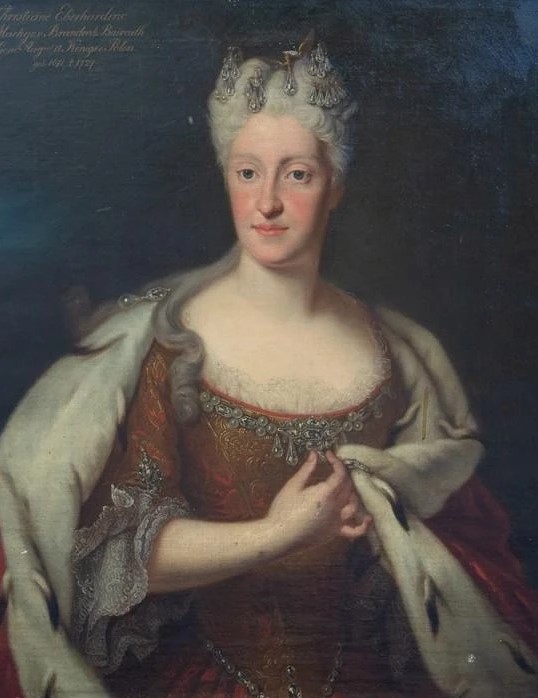For a change, there is a lot we do know about the funeral ode “Laß, Fürstin, laß noch einen Strahl”, BWV 198.
We know it was composed in honor of Christiane Eberhardine of Brandenburg-Bayreuth, Electress of Saxony, who never converted to Catholicism despite political pressure and was revered by protestants as a result, who called her “a pillar of prayer”.
We know that it was a Leipzig well-off student, Carl von Kirchbach, who requested permission from the authorities to hold a memorial service for the Electress at the Leipzig university church (Paulinerkirche). Kirchbach engaged a renowned member of the German Literary Society, Johann Christoph Gottsched, to write the text of the Ode and commissioned the music to Bach.
We also have a solid timeline for the whole affair. Christiane passed on September 5, 1727. Even though we don’t know when exactly Bach received the commission and started work on the piece, we have records of bureaucracy complications regarding the assignment still unfolding on October 11 and 12. The autographed score shows a completion date of October 15, and the performance was two days later, on the 17th.
We even have a press chronicle of the performance, from which we know that it was very well received, that Bach himself played the harpsichord (“in the Italian style”), and that Kirchbach delivered the eulogy between the two sections of the Ode.
Gottsched wrote a poem in 9 stanzas in honor of the Electress, and scholars consider this text one of the highest quality ones that Bach ever set to music, several notches above Picander’s librettos. Curiously, instead of sticking with the natural strophic structure of the text, Bach divided some of the stanzas in half and structured the movements across the poem’s original divisions.
Bach composed all new music for this Ode, and certainly of top-notch quality. The instrumental ensemble includes some relatively atypical members – 2 violas da gamba and 2 lutes – in addition to 2 flutes, 2 oboes d’amore and strings. These choices all are conducive to a soft and muted sonority which is coherent with the occasion (the violas da gamba are frequently associated in Bach’s oeuvre with death and mourning). Bach titled the autograph score “Tombeau de S. M. la Reine de Pologne” which is consistent with his choice of instrumentation in the tradition of the French Tombeau. Also contributing to a colorful and textured piece, all the recitatives are accompanied by different combinations of instruments.
Structurally, the Ode has a longer first section, framed by choruses, and a shorter second section which came after the eulogy, with just 3 movements including the closing chorus.
The opening chorus is in the form of a concerto-grosso, where the pairs of instruments (flutes, oboes, violas da gamba) emerge with solo passages in dotted rhythms in between the phrases of the choir. The broken motifs and frequent appoggiaturas could suggest a funeral procession.
The soprano comes on with a recitative and aria accompanied by the orchestra strings. Bach illustrates the text in the recitative by having the strings play successions of sixteenth notes in descending seconds to represent tears, and in the aria, interrupting their lines on the word “Verstummt” (“be quiet”).
The next two movements are for the alto, and they feature a favorite image to depict death – the bells. Bach masterfully paints a full canvas with staccato notes on the flutes, followed by long notes on the oboes, then pizzicato arpeggios on the strings, violas da gamba and lutes, all coming in successively. Even the continuo team joins in on the illustration, ringing quarter notes in fourths. It’s a breathtaking backdrop to the voice talking about the tolling of the bells and the fear of death.
For the aria, the violas da gamba and lutes take center stage to accompany the voice creating a sonority that’s unmistakably mournful, with the voice in charge of some striking word-painting on key words – “starb” (“died”) and “besiegt” (“conquered”) set to impressively long notes.
A tenor recitative accompanied by the oboes leads to the chorus that closes the first part. This is a 4-part fugal exposition with a theme reminiscent of “stilo antico”, in two sections bridged by the violas da gamba and flutes in an instrumental episode. This is the stanza where, very subtly, the text includes the reference to the fact that the Electress had not converted to Catholicism (“Glaubenspflegerin”, “keeper of the faith”). One wonders if King Augustus was present at the ceremony…
The second part of the Ode, which followed the eulogy, starts with a tenor aria accompanied by a beautiful texture of flute, oboe, violins, violas da gamba, and the lutes with the continuo. It’s set in a rocking triple tempo which lends it a calm, contemplative character, fitting the text. Sustained notes, and long, weaving melismas illustrate the words “Ewigkeit” (“eternity”) and “umsponnen” (“braided”).
The bass gets his turn next, with the only “secco” recitative in the piece. As the text starts mentioning the rivers, the movement turns into an arioso, with a walking bass suggesting the flowing waters. However, the mood turns sour again as the last few lines talk about mourning and loss. The wind instruments highlight the grief with long notes in tense harmonies.
Not for long, though. The final chorus takes us back to a mood of praise and remembrance. The full orchestra engages in a dance-like motif in 12/8. The choir praises the Queen and gives a command to writers of the posterity, coming together into a unison as they prescribe the content of the future poetry.
As he often did with his secular works, Bach reused most of the Ode’s movements in other pieces – a funeral cantata for Prince Leopold of Anhalt-Cöthen in 1729, and the otherwise lost St. Mark Passion in 1731.
